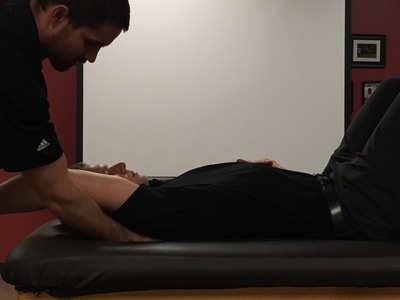- Home
- About Us
- TSPT Academy
- Online Courses
-
Resources
- Newsletter
- Business Minded Sports Physio Podcast
- Day in the Life of a Sports PT
- Residency Corner
-
Special Tests
>
-
Cervical Spine
>
- Alar Ligament Test
- Bakody's Sign
- Cervical Distraction Test
- Cervical Rotation Lateral Flexion Test
- Craniocervical Flexion Test (CCFT)
- Deep Neck Flexor Endurance Test
- Posterior-Anterior Segmental Mobility
- Segmental Mobility
- Sharp-Purser Test
- Spurling's Maneuver
- Transverse Ligament Test
- ULNT - Median
- ULNT - Radial
- ULNT - Ulnar
- Vertebral Artery Test
- Thoracic Spine >
-
Lumbar Spine/Sacroiliac Joint
>
- Active Sit-Up Test
- Alternate Gillet Test
- Crossed Straight Leg Raise Test
- Extensor Endurance Test
- FABER Test
- Fortin's Sign
- Gaenslen Test
- Gillet Test
- Gower's Sign
- Lumbar Quadrant Test
- POSH Test
- Posteroanterior Mobility
- Prone Knee Bend Test
- Prone Instability Test
- Resisted Abduction Test
- Sacral Clearing Test
- Seated Forward Flexion Test
- SIJ Compression/Distraction Test
- Slump Test
- Sphinx Test
- Spine Rotators & Multifidus Test
- Squish Test
- Standing Forward Flexion Test
- Straight Leg Raise Test
- Supine to Long Sit Test
-
Shoulder
>
- Active Compression Test
- Anterior Apprehension
- Biceps Load Test II
- Drop Arm Sign
- External Rotation Lag Sign
- Hawkins-Kennedy Impingement Sign
- Horizontal Adduction Test
- Internal Rotation Lag Sign
- Jobe Test
- Ludington's Test
- Neer Test
- Painful Arc Sign
- Pronated Load Test
- Resisted Supination External Rotation Test
- Speed's Test
- Posterior Apprehension
- Sulcus Sign
- Thoracic Outlet Tests >
- Yergason's Test
- Elbow >
- Wrist/Hand >
- Hip >
- Knee >
- Foot/Ankle >
-
Cervical Spine
>
- I want Financial Freedom
- I want Professional Growth
- I want Clinical Mastery
|
Throwers can be a challenging client for full return to sport. In order to facilitate your plan of care development, check out this complimentary video from Insider Access on advanced exercises for pitchers.
|
|
Ulnar Nerve Compression
Purpose: To determine the presence of cubital tunnel syndrome.
Test Position: Standing.
Performing the Test: The patient is standing and the examiner passively flexes the involved elbow to approximately 20 degrees. Next the examiner places a firm pressure on the ulnar nerve just proximal to the cubital tunnel and maintains the pressure for 60 seconds. A positive test is if the patient reports numbness and/or tingling in an ulnar nerve distribution (ulnar aspect of hand).
Diagnostic Accuracy: Sensitivity: .89; Specificity: .98; -LR:.11, +LR: 44.5
Importance of Test: The ulnar nerve passes in front of the medial head of the triceps brachii and into the bony groove on the humerus (Cubital tunnel). It extends from the medial epicondyle to olecranon and perpendicular to the flexor carpi ulnaris aponeurosis. The sustained position of elbow flexion can place a stretch on the ulnar nerve due to the position of the nerve relative to the bones, which reproduces the symptoms of ulnar nerve compression. In some patients, the ulnar nerve can flip in and out of the cubital tunnel, irritating the nerve. This test looks to reproduce that irritation by applying pressure to the nerve for a sustained period of time.
Note: these tests should only be used by properly trained health care practitioners
Test Position: Standing.
Performing the Test: The patient is standing and the examiner passively flexes the involved elbow to approximately 20 degrees. Next the examiner places a firm pressure on the ulnar nerve just proximal to the cubital tunnel and maintains the pressure for 60 seconds. A positive test is if the patient reports numbness and/or tingling in an ulnar nerve distribution (ulnar aspect of hand).
Diagnostic Accuracy: Sensitivity: .89; Specificity: .98; -LR:.11, +LR: 44.5
Importance of Test: The ulnar nerve passes in front of the medial head of the triceps brachii and into the bony groove on the humerus (Cubital tunnel). It extends from the medial epicondyle to olecranon and perpendicular to the flexor carpi ulnaris aponeurosis. The sustained position of elbow flexion can place a stretch on the ulnar nerve due to the position of the nerve relative to the bones, which reproduces the symptoms of ulnar nerve compression. In some patients, the ulnar nerve can flip in and out of the cubital tunnel, irritating the nerve. This test looks to reproduce that irritation by applying pressure to the nerve for a sustained period of time.
Note: these tests should only be used by properly trained health care practitioners
References:
Neumann, Donald. "Kinesiology of the Musculoskeletal System: Foundations for Rehabilitation." 2nd edition. St. Louis, MO: Mosby Elsevier, 2010. 193. Print.
Novak CB, Lee GW, Mackinnon SE, Lay L. "Provocative testing for cubital tunnel syndrome." J Hand Surg (AM) 1994 September; 19(5):817-20.
Neumann, Donald. "Kinesiology of the Musculoskeletal System: Foundations for Rehabilitation." 2nd edition. St. Louis, MO: Mosby Elsevier, 2010. 193. Print.
Novak CB, Lee GW, Mackinnon SE, Lay L. "Provocative testing for cubital tunnel syndrome." J Hand Surg (AM) 1994 September; 19(5):817-20.
Copyright © The Student Physical Therapist LLC 2023




